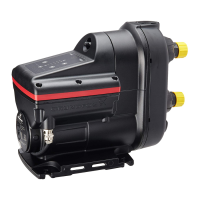6. Electrical connection
Carry out the electrical connection according to local regu-
lations.
Check that the supply voltage and frequency correspond
to the values stated on the nameplate.
DANGER
Electric shock
Death or serious personal injury
‐ Switch off the power supply before you start any work
on the product. Make sure that the power supply can-
not be switched on accidentally.
DANGER
Electric shock
Death or serious personal injury
‐ The pump must be earthed.
‐ The pump is supplied with a grounding conductor and
grounding-type attachment plug. To reduce the risk of
electric shock, be certain that the pump is connected
only to a properly grounded, grounding type receptacle
(protective earthing).
‐ If national legislation requires a Residual Current De-
vice (RCD), a Ground Fault Circuit Interrupter (GFCI),
or equivalent in the electrical installation, this must be
type B (according to UL/IEC 61800-5-1) or better, due
to the nature of the constant DC leakage current.
If the power supply cable is damaged, it must be replaced
by the manufacturer, his service agent or similarly quali-
fied persons in order to avoid hazard.
We recommend that you fit the permanent installation with
a residual-current circuit breaker (RCCB) with a tripping
current less than 30 mA.
6.1 Motor protection
The pump incorporates current and temperature dependent motor
protection.
6.2 Plug connection
DANGER
Electric shock
Death or serious personal injury
‐ Check that the power plug delivered with the product
is in compliance with local regulations.
‐ Make sure that the pump is connected only to a prop-
erly grounded, grounding-type receptacle (protective
earthing).
‐ The protective earth of the power outlet must be con-
nected to the protective earth of the pump. The plug
must therefore have the same PE connection system
as the power outlet. If not, use a suitable adapter.
6.3 Connection without plug
The electrical connection must be carried out by an au-
thorised electrician in accordance with local regulations.
DANGER
Electric shock
Death or serious personal injury
‐ The pump must be connected to an external main
switch with a minimum contact gap of 3 mm (0.12
inch) in all poles.
7. Starting up the product
Do not start the pump until it has been filled with liquid.
7.1 Priming the pump
1. Unscrew the priming plug and pour minimum 1.7 litres (0.45
gallons) of water into the pump housing. See fig. Priming the
pump.
2. Screw the priming plug on again.
If the suction depth exceeds 6 m (20 ft), it may be neces-
sary to prime the pump more than once.
Always tighten priming and drain plugs by hand.
Related information
7.2 Starting the pump
7.2 Starting the pump
1. Open a tap to prepare the pump for venting.
2. Insert the power plug into the socket or turn on the power supply
and the pump will start.
3. When water flows without air, close the tap.
4. Open the highest tapping point in the installation, preferably a
shower.
5. Adjust the pressure setpoint to the required pressure by means
of the
buttons.
6. Close the tapping point.
Startup has been completed.
TM064204
Priming the pump
Related information
7.3 Pressure setting
13
English (GB)

